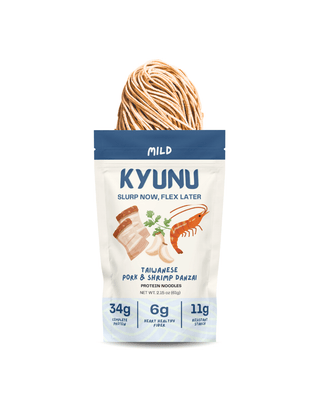There was one Japanese restaurant in my home town of Costa Mesa, CA that has a special place in my heart: Kappo Sui. For over 30 years, I've been making pilgrimages to this culinary sanctuary every time I'm in Southern California. And without fail, I always order their Inaniwa udon—a noodle soup with a rich broth flavored dashi, mushrooms, duck, and a hint of yuzu. This dish is literally perfection, and writing about it has my mouth watering.
Ingredients (for 2 servings, because sharing is caring)
For the broth:
- 4 cups low-sodium chicken or vegetable broth (we're watching that sodium, fam)
- 1 tbsp low-sodium soy sauce
- 1 tbsp mirin or sake + sugar
- 1 small piece of kombu (optional, but it'll make you feel fancy)
- 2 tsp yuzu juice (or see substitution below) or 1 tsp yuzu jelly
- 1 stalk green onions, washed and sliced into 1 inch pieces
- 1/4 cup of shimeji (white beech) mushrooms, washed and separated
- Salt, to taste
- Sugar (or your favorite sugar substitute), to taste
Yuzu Substitution:
- 1 tsp lemon juice
- 1/2 tsp lime juice
- 1/2 tsp orange juice or bitter orange juice
For the toppings:
- 2 six oz duck breasts
- 1 bunch of green onions, sliced diagonally to get thin strips (get that Insta-worthy look)
- 1 sheet of nori, cut into thin strips (for that umami punch)
- 2 soft-boiled eggs (jammy yolks or bust)
- Shichimi togarashi to taste (spice it up, buttercup)
- Yuzu zest or lemon zest for garnish (because we're fancy like that)
Noodles:
- 2 portions of KYUNU Rulebreaker Noods, Original Flavor
Let's Get Cooking!
- Pat the duck dry. Score the duck skin in a crosshatch pattern. Season with salt and pepper.
- Place in a cold 4 quart - 8 quart pot, skin-side down. Turn the heat to medium-low.
- Cook for about 8-10 minutes until the skin is crispy and golden. Be careful of splatter.
- Flip and cook for another 2-3 minutes for medium-rare or when the breast reaches 130°F (54°C) and 140°F (60°C) internal temperature. Note: Consuming raw or undercooked meats, poultry, seafood, shellfish, or eggs may increase your risk of foodborne illness, especially if you have certain medical conditions.
- Remove the breast and wrap loosely with aluminum foil and set aside.
- In the same pot, remove some of the duck fat so that there is only 1 tbsp remaining.
- Add the green onion segments and fry on medium-low heat until browned and crispy.
- Combine the broth, soy sauce, mirin or sake, and kombu if using and add to the pot.
- Bring to boil and reduce to a simmer for about 10 minutes. Remove the kombu.
- Add salt to taste. Note: If you prefer a stronger soy sauce flavor, add more soy sauce.
- Add the yuzu juice (or your citrus substitute) and stir. Decide if you need to balance the flavor with a pinch or two of sugar. It should not be overly sweet. Keep it warm on low heat.
- Bring a large 4 - 8 quart pot of water to a rolling boil.
- Cook the Rulebreaker Noods for 1 - 1.5 minutes in boiling water, ensuring there are no frozen chunks left.
- Drain and rinse briefly with cold water to stop the cooking. We want them QQ (chewy and bouncy), not mushy!
- Unwrap the duck breast and slice thinly on a bias. Use a sharp knife and firm cutting motion to get through the crispy skin.
- Divide the noodles between two bowls.
- Pour the hot, yuzu-infused broth over the noodles. Be sure to get some mushrooms in each bowl.
- Top with sliced duck, green onions, nori strips, and a soft-boiled egg.
- Sprinkle with shichimi togarashi to taste.
- Garnish with a pinch of yuzu or lemon zest for extra aroma.
- Inhale deeply and appreciate that citrusy aroma.
- Taste a spoonful of the rich broth first
- Grab your chopsticks and get ready for a flavor explosion.
- Slurp loudly and proudly – it's a compliment in many Asian cultures!









